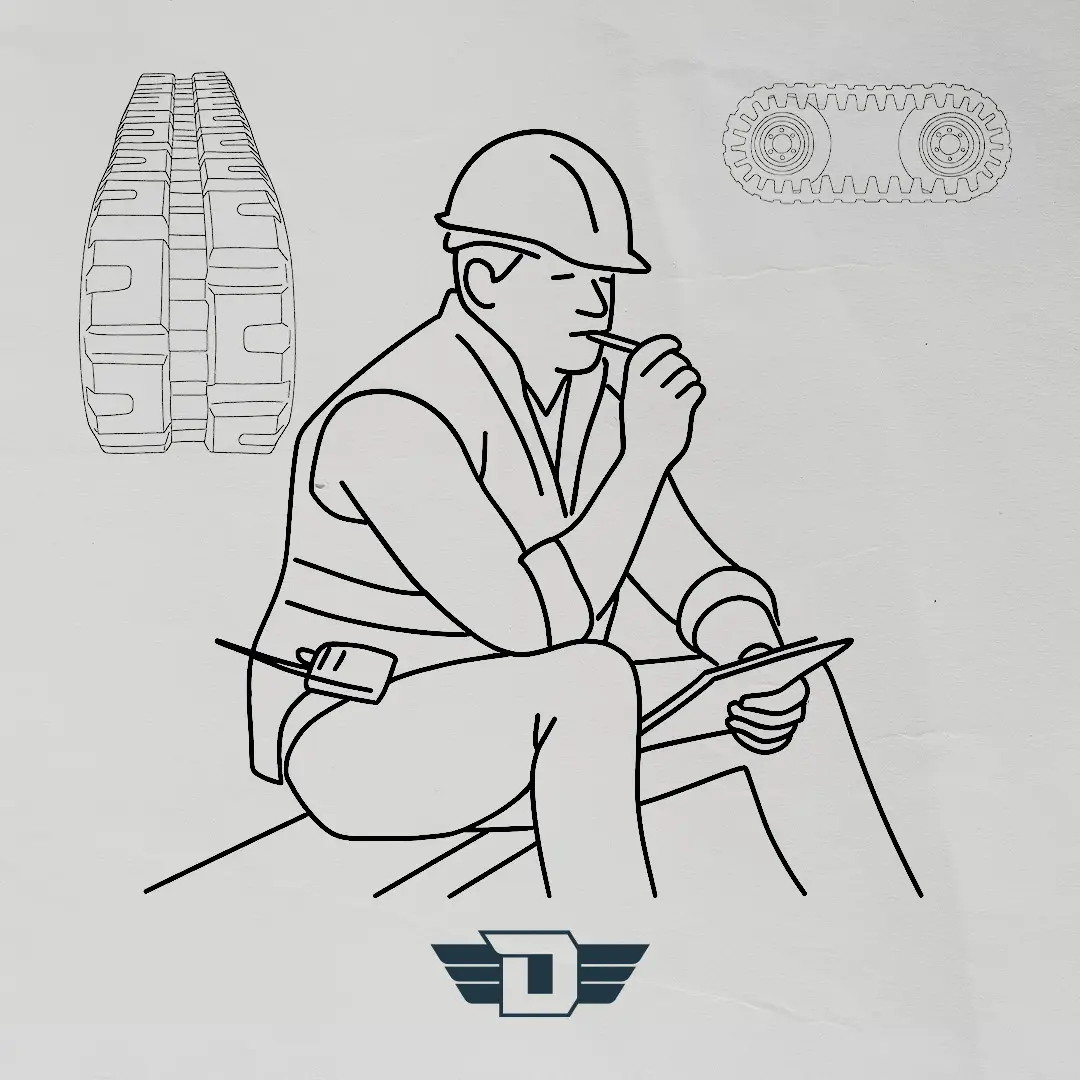- Home
- Buying Guides & Comparisons
- Skid Loader Kubota: The Complete Buyer’s Guide
Skid Loader Kubota: The Complete Buyer’s Guide

TL;DR – Skid Loader Kubota Buyer’s Guide
Match your Skid Loader Kubota model, frame size, and lift type to your main jobsite needs.
Choose tracks or tires based on terrain; Dyne Industries offers durable Kubota track replacements.
Balance torque, horsepower, and hydraulic flow for the attachments you plan to run.
Maintain your Kubota with daily inspections, cleaning, and seasonal track care for longer service life.
Upgrade or replace when workload outgrows capacity to keep productivity and ROI high.
Why Kubota Skid Loaders Are a Top Choice

I’ve been in construction for over 15 years, and if there’s one thing I’ve learned, it’s that downtime eats your profit faster than bad weather. That’s why when it comes to choosing equipment, I’ve become picky — painfully picky.
When it comes to compact equipment, Kubota has earned its spot on Canadian jobsites. Known for their durability, all-weather performance, and operator comfort,
Kubota skid loaders are trusted by contractors, farmers, and landscapers who can’t afford downtime.
Whether you’re moving gravel in July, blowing snow in February, or grading soil in spring, the right Kubota skid loader can keep your projects moving without breaking stride.
In this guide, I’ll walk you through how I choose the right model for each job, what specs actually matter in the real world, and the mistakes I made early on so you don’t repeat them.
What is a Kubota Skid Loader?

A Kubota skid loader is a compact, powerful machine designed for lifting, digging, grading, and material handling.
Kubota makes both skid steer loaders (wheeled) and compact track loaders (tracked) with a universal quick-attach system for swapping out buckets, forks, and other tools.
Who This Guide is For
Contractors needing a versatile machine for construction sites.
Landscapers working in residential or commercial spaces.
Farmers who want a year-round workhorse.
Operators who run equipment daily and need comfort as much as capability.
Kubota's Reputation for Reliability and Performance

Kubota machines have a track record of:
Rugged frames and sealed hydraulics that handle Canadian winters and muddy springs.
Smooth controls that reduce fatigue during long shifts.
Dealer networks that keep you supplied with parts and support.
When I bought my first Kubota SVL75, I was skeptical. The dealer bragged about uptime and comfort, but I’d heard that sales pitch before. Six months later, I was running it 10 hours a day during peak season without a hiccup.
The big difference? The machine felt like it was built with the operator in mind. Every control was intuitive, and even after a long shift, I didn’t feel beat up.

Let's keep you on track
Choosing the Right Kubota Skid Loader for Your Work

Kubota’s Model Lineup Overview (SSV vs SVL)
Here’s how I break it down:
SSV series – If you’re mostly on pavement, gravel yards, or hard-packed soil.
SVL series – My go-to for muddy job sites, winter snow work, or soft ground.
One winter in Fort St. John, we had an SVL97 clearing snow in -25°C. Tracks held traction where a wheeled loader just spun.
Frame Size: Small, Medium, or Large?
I learned the hard way not to oversize just because it “looks” more capable.
We once hauled a large-frame loader to a downtown landscaping project and couldn’t get it through the gated entrance. That day, a small-frame SVL65 would’ve been the hero.
| Frame Size | Best For | Example Models |
|---|---|---|
| Small | Tight spaces, urban worksites | SSV65, SVL65-2 |
| Medium | Balanced performance & portability | SVL75-3 |
| Large | Heavy lifting, industrial sites | SVL97-2 |
Tip: Match frame size to jobsite access, trailer capacity, and the attachments you plan to run.
Lift Type: Radial vs Vertical Lift
I keep both in the fleet:
Radial lift for grading and trenching — less complex, fewer wear points.
Vertical lift for high dumps — like loading tandem trucks with fill.
On a municipal job last summer, the vertical-lift SVL97 saved time off each load cycle.
Tires vs Tracks: What Works Best for Your Terrain
Tires: I use them for demolition work where debris would chew through tracks.
Tracks: Our bread and butter in wet seasons. We cleared a muddy hillside for a retaining wall, and the tracked Kubota walked it without tearing the slope apart.
Power and Performance – What the Specs Actually Mean

Torque vs Horsepower – Why Both Matter
- Torque: Pulling power for pushing dirt or trenching.
- Horsepower: How quickly you can get the job done.
The sweet spot is balancing both for your typical attachments.
Specs on paper can be misleading. On one project, we ran two machines with similar horsepower — but one had noticeably higher torque.
Guess which one pulled the 12″ auger through clay without bogging down?
Lesson: Torque gets the grunt work done; horsepower speeds it up.
Understanding Hydraulic Flow: Standard vs High-Flow
Standard Flow – Enough for buckets, forks, and small augers.
- SSV65: 18 gallons per minute (gpm) standard. You can upgrade to 28 gpm high-flow.
- SSV75: 20.9 gpm standard. You can upgrade to 30.4 gpm high-flow.
High-Flow – Required for power-hungry tools like cold planers, mulchers, and high-capacity snow blowers.
- SVL97-2: High-flow comes standard. It can pump about 40 gallons per minute, which is good for power-hungry attachments.
- SVL97-3: High-flow is optional. It can pump about 41 gallons per minute when equipped.
Get this wrong and you’ll be shopping for a new attachment.
We burned ourselves once buying a standard-flow loader for a milling attachment. It barely turned the drum, and we had to rent a high-flow unit.
Now, I always spec high-flow if there’s even a chance we’ll run heavy attachments.
Common Use Cases and Power Demands
- Snow removal with high-capacity blowers = high-flow needed.
- Landscaping and grading = standard-flow is usually fine.
- Forestry work = high torque and reinforced tracks.

Let's keep you on track
Attachments and Versatility – Get More Out of Your Kubota

Universal Quick-Attach Compatibility
Kubota uses the standard quick-attach system, so you can mix and match attachments from multiple brands.
One winter storm, our snow blower attachment failed mid-shift. I borrowed a competitor’s blower from across the site. Fit right on, no issues. That’s the beauty of universal quick-attach.
Top Attachments for Kubota Skid Loaders
- Buckets (general purpose, 4-in-1)
- Pallet forks
- Snow blowers & plows
- Augers
- Brooms
- Grapples
- Trenchers
ROI Considerations – One Machine, Many Jobs
Every attachment you add extends your machine’s earning power. Think long-term — the right setup can replace the need for multiple machines.
Our SVL75 has paid for itself twice over because it’s run year-round — grading in summer, snow clearing in winter, trenching in spring.
Comfort, Control, and Operator Experience

Cab Design and Entry – Wide Cab and Sliding Front Door
Kubota’s wide cab entrances and sliding doors make entry easy, even with gloves on in winter.
Kubota’s SSV skid steers have a wider cab entrance—about 36 inches wide side to side—so it’s easier to get in and out. This helps if you’re wearing winter gloves or bulky clothing.
The cab also has a roll‑up front door, making it quick to open and close for better airflow or talking to coworkers
Visibility, Joystick Controls, and Pilot Hydraulic Precision
Clear sightlines and responsive controls keep your work precise — especially in tight quarters.
I’ve trained new operators on Kubotas who went from clumsy to competent in one shift thanks to the control feel.
Kubota uses multi‑function levers and ISO pilot controls. These controls give you smooth, precise movements—great for working in tight spaces or doing fine jobs
All-Weather Performance and Enclosed Cab Benefits
If you’re working in Canadian winters, an enclosed cab with heat isn’t a luxury — it’s a necessity.
The SSV skid steers offer heat and AC as standard equipment, so your cab stays warm in winter and cool in summer.
For even more comfort, the SVL75‑3 (a track loader) has a sealed and pressurized cab, which locks in heat, cuts wind, and keeps noise lower—perfect for braving cold Canadian winters.
In -30°C, with heat cranked and defrost on, you almost forget you’re in the middle of a snow-clearing marathon.
Common Mistakes to Avoid When Buying a Kubota Skid Loader

Buying based on price only
It might seem smart to choose the cheapest machine—but you could end up missing important features like better comfort, easier maintenance, or suitable hydraulics.
Ignoring hydraulic flow needs
Some jobs need more powerful attachments that require high‑flow hydraulics. Always check the machine’s flow rate to make sure it can run those tools
Forgetting trailer capacity and transport rules
Kubota skid steers are compact, but you still need to know your trailer’s weight limit and local transport laws to move it safely.
Not comparing skid steer vs. track loader for your terrain
Skid steers work best on hard, dry surfaces. But if you work in mud, snow, or rough fields (like many parts of Canada), track loaders offer better traction and smoother travel
| Feature Category | Kubota Highlights | Why It Matters for Buyers |
|---|---|---|
| Cab entry and visibility | Wide entrance, roll-up door, joystick controls, ISO pilot levers | Easier entry, better control in tight jobs |
| Climate and comfort | Heat & AC standard; sealed cabs on track loaders | Stay warm and productive, even in winter |
| Key buying mistakes | Don’t just chase price; check hydraulics, transport, and terrain needs | Ensures you pick the right machine for the job |
Comparing Kubota vs Other Brands
Reliability and Maintenance
Kubota’s integrated undercarriage is stronger than bolt-on designs, reducing maintenance points.
Kubota’s track loaders (like the SVL models) use a welded undercarriage that’s built as part of the main frame. This means fewer exposed parts—no hoses or weak joints—so the machine is tougher and needs less upkeep.
In contrast, some other brands bolt on their undercarriages. That can mean more parts that wear out, more weak points, and more work for you to keep the loader running smoothly.
Our Kubotas have needed less unscheduled service than the other brands we’ve tried. And when they do, the parts come quick.
Dealer Support and Parts Availability
Kubota has a large, trusted dealer network that’s strong and reliable. You can find dealers easily, and they stock genuine Kubota parts that match the machines exactly.
Having ready access to parts and trained dealers helps you fix problems fast and keeps downtime short.
Last summer, we were deep into a grading contract when one of our SVL75s threw a track. In the old days, that would’ve meant a week of downtime and scrambling for a rental.
But with Dyne Industries, we had a new set of tracks delivered and installed before the next big push.
That job finished on time because both sides came through fast.
Engine Comparison: Why Kubota Builds In-House
Kubota designs and builds its own diesel engines. These engines are a key part of every machine—they’re made for durability, strong performance, and easier service.
Because Kubota makes the engines themselves, they control how they’re built. That helps keep quality high and makes repair or maintenance simpler.
Kubota’s in-house engines have been rock-solid for us. Consistent performance, easy maintenance, and — most importantly — no nasty surprises mid-season. We’ve never lost a job because a Kubota engine failed.
Real-World Operator Feedback
My crew’s picky. They don’t hold back when a machine’s uncomfortable or awkward to use.
With Kubotas, I keep hearing the same thing: smoother controls, better visibility, less fatigue. It’s the kind of feedback that makes me stick with a brand.
Replacement Parts, Tracks, and Maintenance Tips

How Long Do Kubota Skid Steer Tracks Last?
On average, 1,200–1,600 hours, depending on terrain and maintenance — sometimes more if we’re strict with cleaning and tension checks.
I picked up a few tricks from Dyne’s track specialists that have stretched that lifespan, especially on our SVL97s that live in muddy terrain.
Choosing Quality Replacement Rubber Tracks
After a couple of bad experiences with cheap imports, I switched to Dyne Industries for all my Kubota replacements.
Their steel-reinforced aftermarket tracks fit just like OEM and have taken on shale pits, frozen gravel, and clay without a single failure.
It’s one of those upgrades that paid for itself the first time I didn’t lose a day to a broken track.
Look for:
- Steel-reinforced cores
- Continuous steel cords
- OEM-fitment dimensions
Daily and Seasonal Maintenance Checklist
Here’s what we do now — and what Dyne preaches — to keep our Kubota tracks in top shape:
Walk-around inspection every morning to catch damage early.
Grease after every shift in wet or dusty conditions.
Pressure wash the undercarriage before freeze-up so nothing locks solid overnight.
When to Upgrade or Replace Your Kubota Loader
- If your workload has outgrown your machine’s lift capacity.
- When repair costs are stacking up.
- If you’re missing out on jobs because your machine can’t run required attachments.
Make the Right Choice for Your Business

I’ve made some buying mistakes in my career, but I’ve also seen what happens when you get the choice right.
The right Kubota skid loader — matched to your workload, paired with the right attachments, and backed by suppliers you can count on like Dyne Industries — will pay for itself, keep your crew moving, and cut your stress in half.
If you’re serious about productivity, don’t just buy on specs. Buy what’s been proven on real jobsites.

Let's keep you on track
FAQs About Skid Loader Kubota
People like Kubota because its machines are tough, fuel-efficient, and long-lasting. They also offer good resale value and have a strong dealer network that makes getting parts or help easy. Users mention reliable performance and fair pricing compared to higher-end brands.
This depends on what you need. John Deere is known for advanced features, especially in large farms. But Kubota often wins when it comes to price, dealer access, and performance in smaller to midsize jobs.
Kubota is often praised for reliable engines, comfort, and visibility. Bobcat used to use Kubota engines but switched to Doosan engines around 2015 to meet emissions rules. The two brands offer similar power, but some users say Kubota’s system works more smoothly in tough conditions.
Yes—they’re worth the money for most users. They’re reliable, durable, easy to use, and affordable. They also save on fuel and maintenance costs.
Kubota is a Japanese company, based in Osaka, Japan.
Kubota has acquired and invested in various companies:
Became the majority shareholder of Kverneland Group (Norway) in 2011
Bought Great Plains Manufacturing (North America) in 2016
Invested in Escorts Limited (India), Buhler Industries, and more
Acquired parts of Officine Bieffebi (Italy) and AgJunction, among others
Yes, they are known for their quality, fuel efficiency, and strong performance across different machine types.
Yes—Kubota has factories in Germany, including in Zweibrücken (minibaggers and wheel loaders) and Rodgau (engines, tractors, construction equipment).
- best skid steer for snow removal
- kubota skid loader buying guide
- kubota skid steer
- kubota skid steer attachments
- kubota skid steer comparison
- kubota skid steer frame size
- kubota skid steer horsepower
- kubota skid steer hydraulic flow
- kubota skid steer maintenance
- kubota skid steer specs
- Kubota skid steer tracks
- kubota vs bobcat skid steer
- radial vs vertical lift skid steer
- skid loader kubota
- skid steer tires vs tracks
Bobcat tracks explained: Get the facts on hours, upkeep, and smart replacements so you save money and keep working.
How to Pick the Best Tracks for Your Skid Steer (Without Guesswork)





